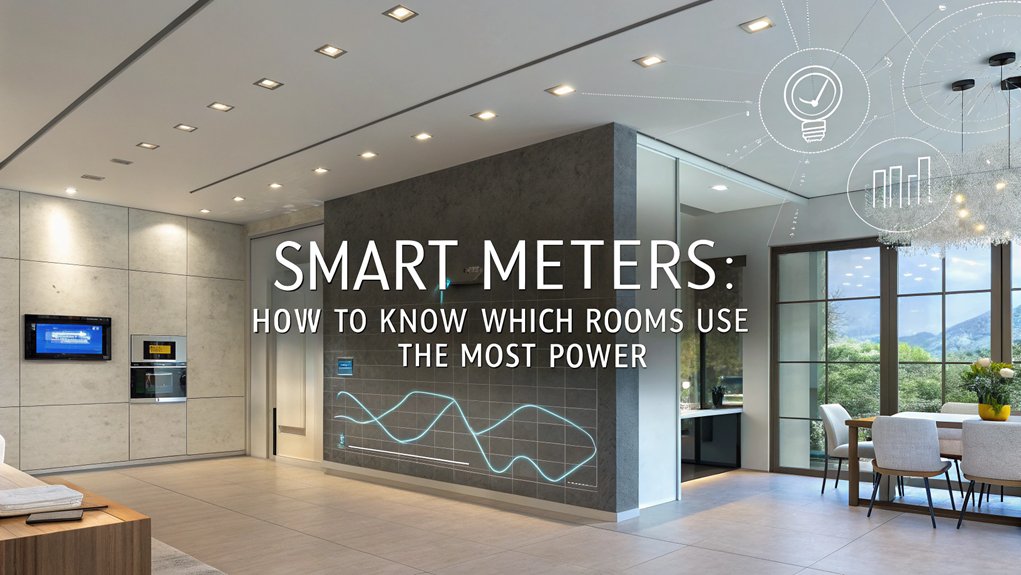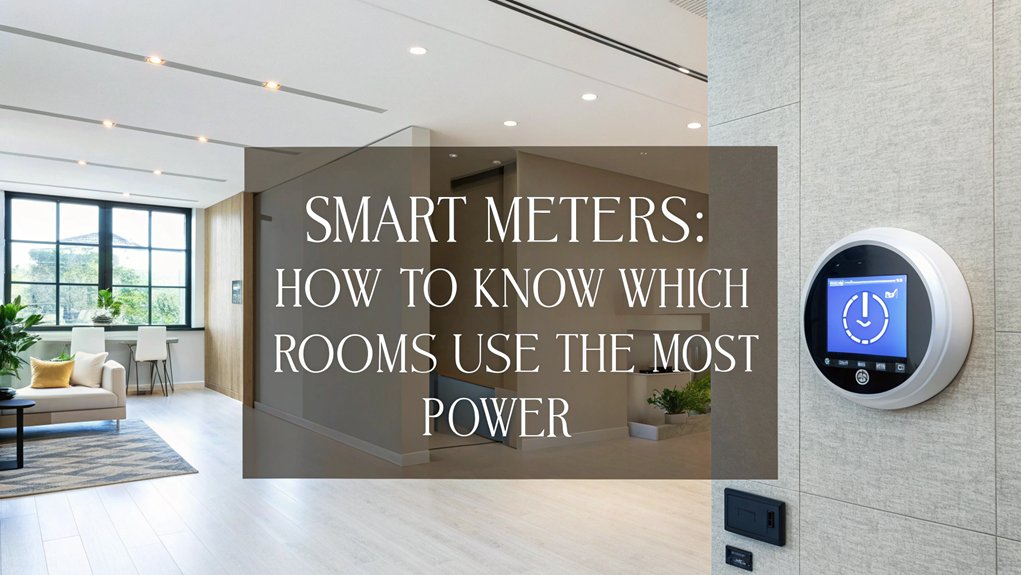Smart meters help you pinpoint which rooms use the most power by providing real-time energy data. They can break down overall usage per room, enabling detailed analysis of consumption patterns. Identify peak times and correlate data with household activities to see which rooms are energy-intensive. This insight helps make informed decisions about energy efficiency improvements. To uncover more about maximizing the benefits of smart meters for efficient energy use, continue exploring the possibilities.
Key Facts Summarized
- Smart meters provide real-time data that breaks down energy usage by room for detailed insights.
- Analyzing energy consumption patterns helps identify peak usage times for each room.
- Correlating energy data with household activities pinpoints energy-intensive rooms.
- Regular monitoring of room-specific usage patterns guides efficiency improvements.
- Smart meters detect anomalies, helping to identify rooms with unusual energy consumption.
Understanding Smart Meter Technology
Although it might seem complex at first, understanding smart meter technology is essential for modern energy management.
Smart meters automatically track and transmit real-time energy data to utility companies, typically every 15 minutes. This frequent monitoring of energy consumption allows you to receive accurate utility bills and manage your energy usage more effectively.
By distinguishing between peak and off-peak usage periods, smart meters enable you to adjust your habits, potentially reducing costs. With in-home displays, you can instantly access energy data and monitor usage patterns, making your home more energy efficient.
These devices support advanced energy monitoring strategies and, through cloud connectivity and data analytics, they help promote sustainability. Additionally, smart meters enhance grid reliability by quickly detecting outages and anomalies.
Ultimately, smart meters empower you to optimize energy consumption and reduce waste.
Analyzing Room-specific Energy Consumption
Smart meters not only track overall energy usage but also break down consumption by room, offering a granular view of where electricity is being used the most.
By analyzing room-specific energy consumption, you can identify peak electricity usage times and optimize energy efficiency. Here’s how you can use smart meters to track energy usage effectively:
- Monitor real-time data: Use in-home displays connected to smart meters to observe energy consumption patterns by room.
- Identify peak usage times: Analyze meter readings to determine when rooms consume the most power supply.
- Correlate with activities: Match energy consumption data with household activities to pinpoint energy-intensive rooms.
- Implement energy-saving measures: Regular analysis can guide renovations and upgrades, enhancing overall energy efficiency. Additionally, engaging with whole-home energy monitors can provide deeper insights into energy use patterns across all rooms.
This approach allows informed decisions on energy-saving measures.
Identifying High Usage Appliances
Ever wondered which appliances are silently driving up your electricity bill? Smart meters are your ally in pinpointing high usage appliances that inflate your electricity consumption. By providing real-time energy use data, these energy meters let you track individual appliance usage. Consider refrigerators and HVAC systems, which can account for up to 50% of your household’s total energy consumption. Pairing smart meters with smart plugs helps identify energy hogs for potential replacement or reduced use, leading to energy efficiency improvements. Regularly reviewing data aids in adjusting usage patterns, such as operating appliances during off-peak hours to reduce overall electricity costs. Additionally, using electricity usage monitors can help you measure specific device consumption more accurately.
| Appliance | Average kWh/year | Percentage of Total Energy Use |
|---|---|---|
| Refrigerator | 100-800 | 10-15% |
| HVAC Systems | 2000-3000 | 20-30% |
| Water Heater | 300-4500 | 15-25% |
Implementing Energy-saving Strategies
Once you’ve identified where your energy consumption spikes, you can take decisive action to implement energy-saving strategies that make a significant impact.
Smart meters offer insightful data to optimize energy use effectively. Here’s how you can reduce electricity costs:
- Upgrade to Energy-efficient Lighting: Replace traditional bulbs with LED lighting in high-consumption areas. LEDs can cut electricity usage by up to 80%.
- Target High-energy Usage Appliances: Analyze smart meter data to replace or adjust usage patterns of inefficient appliances.
- Schedule Off-peak Tasks: Use smart meters to identify off-peak hours for energy-intensive activities like laundry, reducing costs.
- Adopt Better Habits: Regularly review data to develop habits like turning off lights and unplugging devices, minimizing unnecessary consumption.
- Consider Circuit-level Monitoring: Implementing circuit-level monitoring can provide detailed insights into energy consumption and help identify energy vampires that may be contributing to high costs.
These strategies will help you manage your electricity usage effectively.
Benefits of Monitoring Energy Usage
Identifying energy consumption patterns through smart meters reveals a wealth of opportunities for reducing electricity costs. By monitoring energy usage, you can pinpoint which rooms consume the most power, allowing for targeted energy-saving measures.
Smart meters provide real-time data on electricity usage, helping you track usage patterns and identify energy-hogging appliances. This insight enables you to optimize energy efficiency, potentially saving 10-30% on monthly energy bills.
Analyzing energy consumption data empowers you to make informed decisions about appliance upgrades or adjust usage habits to conserve energy. Utilizing smart meters and energy monitoring apps, you can set consumption goals and receive alerts, promoting proactive and efficient energy management. Additionally, understanding phantom power can help you identify devices that contribute to unnecessary energy consumption.
Ultimately, understanding your energy usage fosters significant behavioral changes and long-term savings.
Frequently Asked Questions
How to See What Is Using the Most Power?
To identify what’s using the most power, access your smart meter’s data via an app or in-home display.
Analyze the real-time and historical consumption data for patterns. Check individual device usage if your meter supports this feature, and compare peak versus off-peak trends.
Use these insights to spot high-energy devices. Adjust habits or upgrade appliances in areas with excessive power use for better energy efficiency and cost savings.
Why Is My Smart Meter Showing High Usage When Nothing Is On?
If your smart meter shows high usage when nothing’s on, it might be due to phantom loads from devices in standby mode.
Chargers and appliances can still draw power. Check for any anomalies that could indicate a malfunctioning meter.
Consider seasonal changes or peak demand times affecting your readings.
Monitor your real-time data closely to identify unusual patterns and pinpoint devices or appliances causing unexpected energy consumption.
How to Track Electricity Usage per Room?
Did you know that the average household spends 12% of its energy consumption on lighting alone?
To track electricity usage per room, install smart plugs or power strips that monitor individual devices. Consider using the Sense Energy Monitor for real-time data or connect smart meters to apps like Zerofy.
Analyzing this data helps you pinpoint energy hogs, enabling efficient management and potentially reducing your electricity bill.
How to Check Which Appliance Is Using Too Much Electricity?
To check which appliance is using too much electricity, start by using a smart energy monitor. It provides real-time data on device consumption.
Consider plug load meters to measure specific appliances over time. Analyze trends using the smart meter’s features and energy monitoring apps to spot peak usage.
Conduct an energy audit by unplugging devices and noting changes. This data-driven approach will help you pinpoint energy-hungry appliances efficiently.
Conclusion
By embracing smart meter technology, you gain valuable insights into your home’s energy consumption. Rooms whisper their secrets of inefficiency, revealing energy-hungry appliances that inflate your bills. Analyze this data critically, and you’ll uncover opportunities for savings. Implement these insights to cut costs and reduce your carbon footprint. Remember, knowledge is power—quite literally. With informed decisions, you’re not just saving energy; you’re investing in a sustainable future. Let your home’s numbers guide you to smarter energy use.

